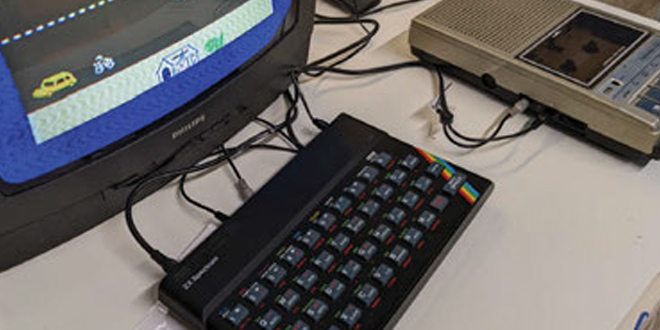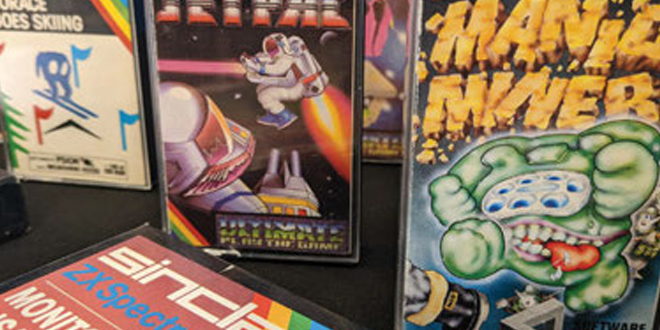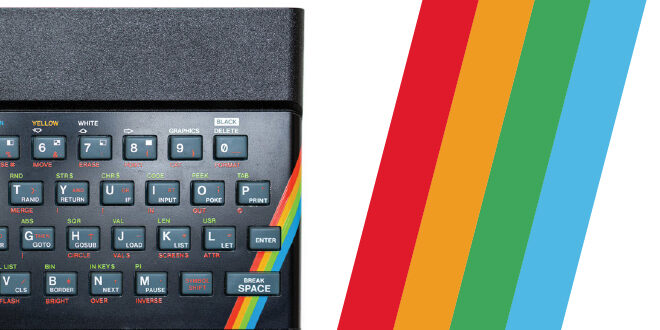There have been many significant days in the history of the UK games industry, but the launch of the Sinclair ZX Spectrum was arguably the first of them. I went to meet two people that helped make it happen.
Can you remember where you were on the 23rd April 1982? No, neither can I, but unlike a number of you fine people reading this, I did at the time exist in human form – albeit in the shape of an awkward pre-teenager. What I do remember vividly is what happened afterwards, because it was the day that the Sinclair ZX Spectrum was launched and the world was forever changed.
True, it wasn’t the first home computer and it certainly wasn’t the most capable, but with its synthpop stylings the Spectrum looked like nothing else around. More importantly for the parents being badgered into purchasing one (on the pretext that it would facilitate the timely completion of school work), it was cheap. Not just cheaper than every other comparable computer, but the same price as the best-selling console, the Atari VCS, which had been on the market for four years already and thus considered obsolete.
The ZX Spectrum was of course the brainchild of the late Clive Sinclair, the serial entrepreneur and inventor who came to prominence in 1972 with one of the world’s first – and by far its cheapest – pocket-sized calculators.
He would later become infamous for the disastrous but prophetic C5 electric car. In 1982, however, his star was still in the ascendancy, having enjoyed considerable success with the ZX80 and ZX81 computers. Seeing the potential in the home computer market and keen to outmanoeuvre rivals Acorn and Commodore — Acorn especially — Sinclair pushed to launch the ZX81’s successor within just ten months, a remarkable turnaround for the time, even without the fact that the Spectrum would be offer numerous upgrades — more memory (16k base model), colour graphics (15), sound capabilities (the ZX81 was mute) and a “proper” keyboard, to name but a few.

TECHNICIAN TED
Chief among the team charged with developing the ZX Spectrum – designated the ZX82 – were Steve Vickers and Richard Altwasser. Vickers, fresh from having completed a PhD in algebra, admits to knowing nothing about Sinclair’s computers, but was offered a role at tech consultancy firm Nine Tiles, which had created the firmware for the ZX80: “I quickly slotted into the ZX81 project and wrote the firmware and manual for it, then the Spectrum came on the horizon and I moved onto the team for that and did the firmware and the manual for that as well.”
Altwasser was also relatively new, joining Sinclair Research under Jim Westwood, the company’s most experienced technician at the time. After the launch of the ZX81, Westwood was assigned to work on Sinclair’s abortive flatscreen TV project. “And so I inherited the next computer project from him,” says Altwasser. “I had developed the printed circuit board for the ZX81 and then moved on to develop the hardware and the ULA (uncommitted logic array) and printed circuit board for the Spectrum, working very closely with Steve.” Success had made the Spectrum inevitable. Sinclair’s first kit computer, the MK14, sold more than 15,000 units during the late 1970s, mostly to electronics enthusiasts. The ZX80 sold somewhere between 50-100,000 units and was therefore considered a huge success. The ZX81, with its 1k of memory (expandable to 16k) – went on to sell 1.5 million units.
Working as a contractor, Vickers wasn’t privy to the sales figures and had no contact with anyone at Sinclair outside of its small technical team, but he was impressed with how approachable Sinclair’s machines were and how they were being marketed: “I was astonished at the idea that you could just plug in a computer and it didn’t have to boot up, unlike subsequent computers. It was just a technological marvel to me.” “I remember talking to John Rowland, who was a senior marketing person at WH Smith,” adds Altwasser. “They were selling the ZX81 and a lot of computer programmes and computer magazines. And he said to me that for WH Smith, computer magazine sales had exceeded sales of women’s magazines. That sums up the success of the ZX81.”
CHIP CHALLENGE
Vickers recalls the early days working on the Spectrum as more iterative and instinctive rather than feature-driven. “We didn’t know all the features that were going to go in and how they would work, or how Sinclair BASIC was going to be augmented. But pretty much from the start it was going to be a ZX81 plus extra stuff. You started off making the best, most sophisticated computer you could within the time scales,” he says. “There’s just a natural progression.”
As an employee, Altwasser was more aware of the market that Sinclair was aiming for: “Within the company it was recognised that there were two markets. There were the people that wanted to learn programming — and a lot of computer magazines had pages and pages of code that young people were just sitting and typing in, and of course there were the games.” To appeal to both, colour and sound were essential, as were higher resolution graphics (256×193, versus the ZX81‘s 64×48 block graphics mode).

What the team were up against was the imperative to keep costs low and to hit a very particular deadline, specifically the 23rd of April 1982, when the UK computer industry would descend upon Earl’s Court for the annual Computer Fair. “Clive had a formula that was sales price including VAT was four times the component cost,” says Altwasser,“and so the myth of Clive coming in and looking over an engineer’s shoulder and asking him, only slightly tongue-in-cheek, ‘So what would happen if that component was removed?’ was very real. And it kept us engineers on our toes. So we had to make compromises in order to meet the £125 take-home price.” One of which was the colour graphics scheme would only allow one attribute byte per character to define foreground, background colour, flashing and highlighting – which resulted in the Spectrum’s distinctive attribute clash; hideous to behold in many early games, but which over time programmers learnt to get around and use to their advantage.
Altwasser is not at all defensive about the Spectrum’s graphical shortcoming, and indeed remains rather proud of the economy that was maintained: “People have said, why didn’t we have true high resolution colour, where you could individually address the colour of each individual pixel on the screen? Or why didn’t we have hardware sprites moving about the screen? Of course, we could have all of those things. The technology was available and we knew how to do it. But we had a price point to hit.”
“The myth of Clive coming in and looking over an engineer’s shoulder and asking him, only slightly tongue-in-cheek, ‘So what would happen if that component was removed?’ was very real” — Richard Altwasser
RICHARD ALTWASSER ON CLIVE SINCLAIR
“He cultivated this public persona of being a slightly eccentric inventor and one of his often repeated statements was that Sinclair Research exists to invent and the only reason that Sinclair Research sells products was to fund the research.
This helped to build up his persona and so a lot was written about him. “People wanted to know what he was going to say and wanted to know what his next products were going to be. So you know, one could perhaps compare him with Elon Musk today; he says something that has absolutely no relevance at all to any of his business interests, but everybody publishes it. “Now, certainly with some of my colleagues, that brought some criticism. People would say ‘the man is egocentric’, ‘he talks about himself’, ‘he’s building up his own image’, ‘he should be talking about the product’, but I think those criticisms missed the subtlety. He created this public persona and people were interested to hear about what he had to say to write about it. Of course, in a very subtle way, that promoted the company and promoted the products. “I’d also say that he was very demanding. We would expect to hear the sharp end of his tongue, but he was also a generous man.”
LORDS OF MIDNIGHT
Another compromise of the Spectrum’s design was its ‘full-size moving-key keyboard’, which was quickly characterised as feeling like dead flesh, despite being a vast improvement on the membrane keyboards of the ZX80 and 81. Part of the problem was that each key had up to five context-sensitive commands attributed to it, which made learning BASIC as much a battle with the keyboard as with programming itself. Although, for those that spent their days typing in game listings from magazines, muscle memory soon kicked in. The outward appearance of the original ZX Spectrum was for all its limitations and frustrations an inspired piece of work – one of the many award-winning designs of the late Rick Dickinson, who after Sinclair Research went on to design the Gizmondo and the recently remodelled Spectrum Next.
However, before its fans could get to appreciate his work in turning the Spectrum’s shortcomings into timeless distinctions, there was the small matter of having the machine ready for launch, which in the early spring of 1982 was by no means assured. “It was certainly no more than a week before the launch that we had to start the production line,” remembers Altwasser, who was sent to Cambridge airport with Sinclair’s engineering team to board Sir Clive’s private jet. “We flew down to the Isle of Wight, picked up some keyboards, flew up to Dundee to the Timex factory, then we helped assemble as many computers as we thought would fit in this small aircraft and flew back to Cambridge ready to take them to the Computer Fair.”
THEY SOLD A MILLION
In spite of the time and cost constraints, and some bugs that would have to be addressed later, the first production models of the Sinclair ZX Spectrum were prepared for launch, ready to be revealed at the 1982 Earl’s Court Computer Fair, which was heaving with anticipation “Throughout the morning, people were four deep around the stand,” remembers Altwasser of the Spectrum’s unveiling. “Clive had made a statement, something to the effect that the first thousand customers to pay with cash – which was always good in business – would get a Spectrum within a certain limited timeframe… I’m not sure how accurately that was specified … and I remember, it must have been late morning, we were gasping for a cup of tea and Steve and I walked out and we’re going up this very wide staircase behind a couple of school boys, listening to them. They were talking about the Spectrum and they were going through every fine detail of the hardware that we’d laboured over for nearly a year. They’d only heard about it maybe an hour or two earlier and they understood and were enthused about every detail. That was rewarding. That was surprising.”
Despite the immediate and lasting success of the ZX Spectrum – it would sell more than five million units until it was discontinued in 1992, Vickers and Altwasser did not stay long in the employ of Sinclair Research and in fact within a few months had set themselves up in direct competition, releasing the unsuccessful Jupiter Ace computer towards the end of 1982. In Sinclair User magazine that year, Altwasser said “We had plenty of freedom working at Sinclair, but at the end of the day the company was run by one man and if a decision needed to be made, there was one man who took that decision.” In the same interview Steve Vickers was a little less guarded: “There is a definition of a deadline; that it is the date before which something should not be completed, but that is not the case with Sinclair.”
“One of the hardest things to teach is that programming is a creative activity. It’s not just about knowing the rules for the programming language. It’s about how to have enough control over the computer so that you can get it to do creative things. That’s what people were learning with the Spectrum” — Steve Vickers
SCRATCH DAY
Forty years on, after long careers in industry and academia, Altwasser and Vickers are clearly very proud of their contributions to early home computer industry and to Sinclair’s in particular, “When you look back, despite being just a games machine, the Spectrum was hugely educational,” says Vickers. “One of the hardest things to teach is that programming is a creative activity. It’s not just about knowing the rules for the programming language and learning how to avoid compiler errors and all that stuff.

It’s about how to have enough control over the computer so that you can get it to do creative things. And that’s what people were learning with the Spectrum, which is the basis of the games that came out. “ Altwasser adds: “I’ve worked in industry, electronics and software management and I’ve seen and recruited a huge number of people who cut their teeth as teenagers on the ZX Spectrum and have gone on to very rewarding careers. There was this virtual circle whereby because of the price point, lots of people bought it. Lots of people wrote games, and because they were good games, more people bought them.” While he understands the appeal of the Spectrum at the height of it’s 80s success, Altwasser is at a loss to explain how it’s popularity has been sustained for more than forty years, with games still released in their hundreds each year. “I’m completely surprised and shocked,” he says. “Do I understand it? I don’t, I’m sorry.”
Altwasser is more comfortable talking about the Spectrum’s legacy, but rather than mention the obvious successor, the Raspberry Pi, he suggests Scratch as the successor to the Spectrum, in that like Sinclair’s machine, the popular MIT-created programming language succeeds in making learning accessible. “I’ve seen young people, five, six years old, become completely addicted and I stand in awe of the MIT people that develop Scratch. If anybody of any age can enter a few keys and see something useful or interesting happening on the screen within a few minutes, before they know it they’re on the road to a career in computing.”
Scratch will be forty on 15th May 2047. If I’m not in a fit state to mark the celebration, can one of you please remind my successor of their obligation? Thanks.

 MCV/DEVELOP News, events, research and jobs from the games industry
MCV/DEVELOP News, events, research and jobs from the games industry




